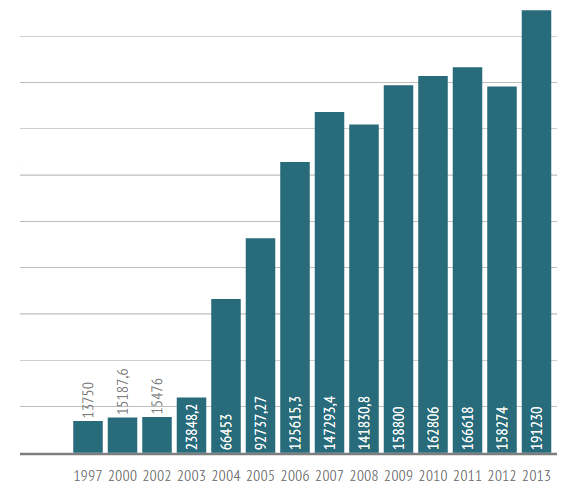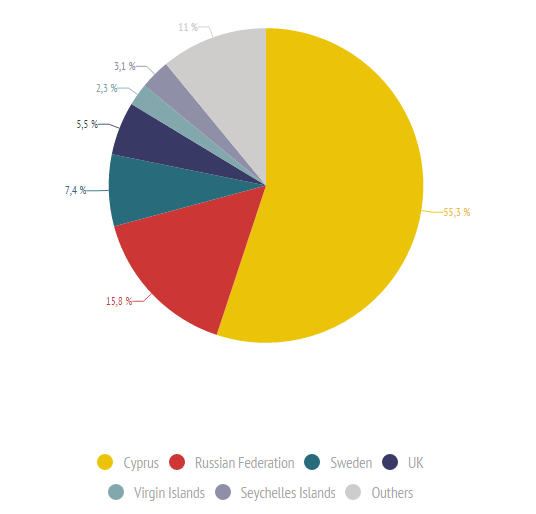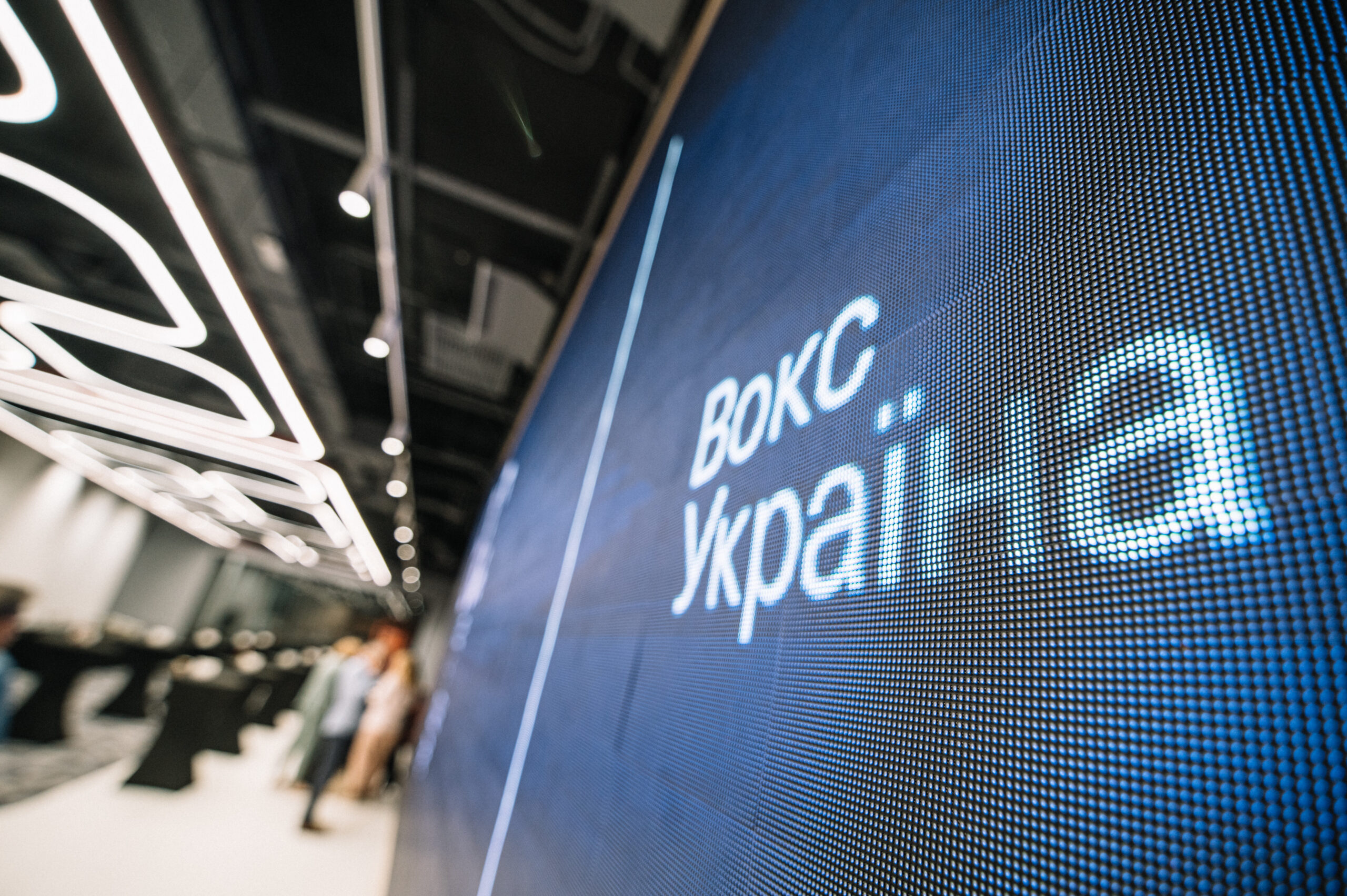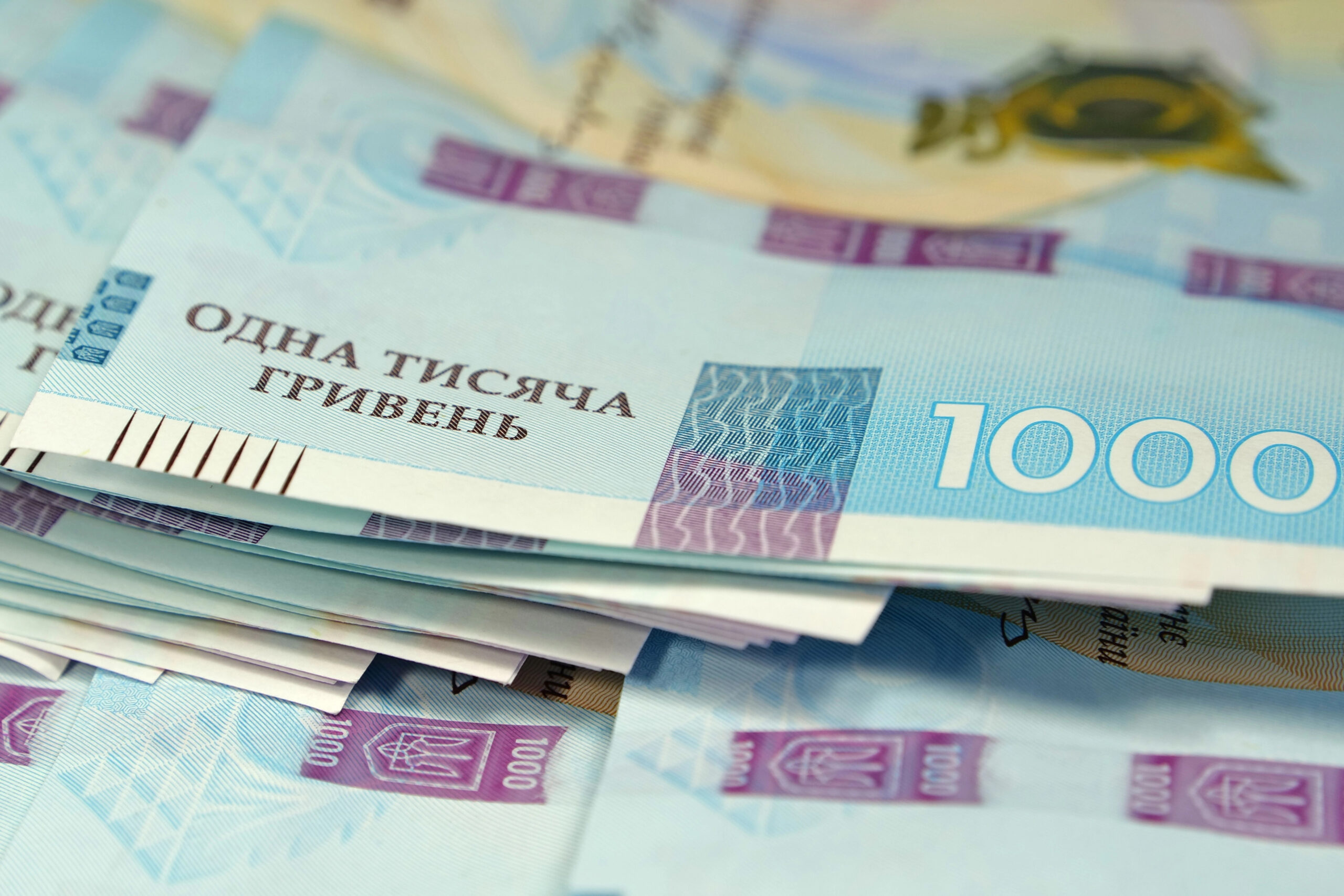This article is aimed to raise a number of issues that are important for the understanding of the situation in the occupied Crimea with respect to investment and foreign trade. In particular, it shows how the current situation is significantly different from the pre-occupation period, elaborates on the plans of the local self-proclaimed authorities for raising investment attractiveness of the region, considers the prospects of international economic cooperation of Crimea under current conditions.
Part one: investment policy in Crimea before the occupation
From the very beginning of the Crimean crisis the issue of investment into the Crimea became one of the most vividly discussed among the apologists of “reunification”of Crimea with Russia. The issue was brought to public as early as February 2014, when the territory of the Autonomous Republic of Crimea was invaded by world-famous Russian “little green men”. Later, local self-proclaimed government promised that Crimea investment paradise would just roll over. The issues of military and strategic nature for the annexation of the Crimea were assigned to Igor Strelkov, Alexander Boroday and the number of others, while it was the famous trio – S. Aksenov, V. Konstantinov and R. Temirgaliev – whose task was justification of the “reunification” of Crimea with Russia on the ground. At the same time, local population was promised mountains and marvels, and a huge investment in the peninsula, both Russian and foreign. A number of studies were published to prove that allegedly under Ukrainian rule the Crimean peninsula was plunged into systemic corruption and purposefully turned into a subsidized region.
The international response to the annexation of the Crimea was sharply negative, it was condemned by the Western countries and international organizations such as the OSCE, Council of Europe and the United Nations. On March 27, 2014, the resolution No 68/262 “Territorial integrity of Ukraine” was adopted by the UN General Assembly. Then followed international sanctions against the Russian Federation for its violation of the territorial integrity of Ukraine and against the pro-Russian Crimean leaders. International sanctions practically banned any investment activity in the Crimea but so far they did not induce neither Russian nor self-proclaimed Crimean authorities to change their policy.
General characteristics of investment policy in Crimea before the occupation
The issue of attracting the direct foreign investments became topical after the start of the EU special project “Joint Cooperation Initiative in Crimea” in 2010. Within the framework of this Initiative several projects were launched, among them “Crimean Tourism Diversification and Support” (Feb. 2012) aimed at key challenges that constrain the development of tourism in Crimea. In Sevastopol in 2012, a more specialized international project “Foreign Direct Investment promotion in Sevastopol” was launched.
Besides the EU, investment attractiveness of the region was developed by the American International Agency USAID through the project “Local Investment and National Competitiveness” (LINC). The purpose of the program was “to improve [Crimean] business and investment environment by streamlining the work of permit-issuing one-stop shops and enhancing the ability of key industries to integrate Crimean goods and services into higher-value markets”.
These projects were launched in the Crimea for two reasons. The first is Russian-Georgian war (August 2008), by which the Kremlin started its aggressive policy of “protection of the rights of Russian citizens.” At that time many European capitals and Washington clearly understood that a peaceful and gradual “Taming of the Shrew” would not work [for example see here and here]. The second factor was signing the “Kharkiv agreements” on April 21, 2010. By these agreements Russia got consent from the Yanukovych regime to prolong the accommodation of its Black Sea Navy fleet until 2042 instead of 2017, in exchange for a discount on gas price.
After the Russian-Georgian conflict in 2008, the Crimea and Sevastopol have seen a flurry of diplomatic missions. Simferopol and Sevastopol had been visited by ambassadors and experts from different European countries, as well as by representatives of international organizations. For example, in 2008, ambassadors of the Czech Republic, Slovakia and Hungary visited the Crimea. In 2009, representatives of diplomatic missions of Canada, Hungary, Slovakia, the Czech Republic, and Japan came to Crimea. It should be taken into account that the Crimean Autonomous Republic was in fact an ordinary administrative entity possessing symbolic autonomous rights, and therefore visits of several diplomatic missions per year had been a matter of extraordinary importance.
After the signing of the Kharkiv agreements in April 2010, the number of diplomatic missions increased exponentially – ambassadors of Turkey, USA, Canada, Germany, France, Norway, Lithuania and Slovakia; Mission of Scotland, Denmark, the EU, the Visegrad States, the OSCE, Minister of Foreign Affairs of Sweden and several other representatives of various EU countries visited Crimea.
It should be noted that every official visit implied an investment component, and each diplomatic mission arrived with a unique investment proposal. For instance, Swedish Government together with the EBRD wanted to help construct a modern industrial wastewater treatment plant in the Crimea.
After the Russo-Georgian war in 2008, Brussels and Washington turned their special attention to Black sea region. By means of investment and business activities of European and American entrepreneurs EU and US tried to “stake out” and anchor their presence in the Crimea and Sevastopol.
It is interesting that in 2009 after the news that US was going to open a Consulate office in Simferopol, the deputies of the Crimean parliament took a tough stance on this possibility. The EU’s “Eastern Partnership Initiative” in Crimea was established for the same reason – to forge closer ties between EU, Eastern European and the South Caucasus countries (see 1, 2).
Pilot projects started by the European Union in Crimea implied far-reaching political objectives. the European Union wanted to cooperate with the Crimean authorities, despite the fact that European businesses have developed quite clear understanding of the corruption of Ukrainian bureaucracy, particularly the Crimean political and economic “elite” which mostly stems from various kinds of criminal groups. One of the most pronounced example is current leader of the self-proclaimed republic Sergei Aksenov who entered onto political scene from the Crimean criminal gangs.
The project “FDI promotion in Sevastopol” turned out to be in far more complex and ambiguous situation than projects that were implemented elsewhere in the peninsula. In the Crimea, the EU project representatives could turn for advice and cooperation to already established organizations, such as UNDP Office in Crimea, Canadian International Development Agency and a few others. In Sevastopol it was the first and unique project. There, the issue of investment development in the region became a bargaining chip for the local political elite, which successfully slowed down the process of project implementation [2].
In Sevastopol, the main problem for the project implementation was complete indifference of authorities and their desire to sweep everything under the carpet. In addition, the project was constantly criticized by the pro-Russian officials and community leaders of the city.
Pilot projects in Sevastopol and the Crimea have never reached the final stage due to the annexation of the peninsula by Russia in February 2014 and as a result, several years of hard work of experts became irrelevant in the new geopolitical realities. However, the tribute must be paid to the very concept of such projects. Positive results of them were evident.
Unfortunately, the new occupation authorities have their own understanding of investment policy and started all over with investment strategies, standards, programs completely different from those developed by Ukrainian specialists with the help of international investors.
Before proceeding to the presentation and analysis of Russian policy in the Crimea we briefly show the investment statistics of Crimea and Sevastopol before the occupation.
FDI to Sevastopol and Crimea
At the end of 2013 the volume of foreign direct investment in Sevastopol was USD 191.1 million, which is 22.6% more than at the beginning of 2013. The cumulative volume of FDI per capita amounted to USD 499.7 (Figure 1).
Figure 1. Dynamics of foreign direct investment cumulatively (31.12.2013), thousand USD
Source: Social and economic statistics in Sevastopol
Investment came to the city from 33 countries. The main FDI sources were Cyprus (actually Ukraine) and Russian Federation (Figure 2).
Figure 2. Distribution of FDI by countries – investors
Source: Social and economic statistics in Sevastopol
In terms of attracting foreign investment, Crimea was in the top ten among the regions of Ukraine. As of October 1, 2013, foreign direct investment amounted to 1.54 billion USD (cumulative since 1994). Foreign direct investment per capita amounted to 786.3 USD. During January-September of 2013 foreign investors invested to Crimea 110.2 million USD.
Figure 3. Foreign direct investment in the Crimea in 2003-2013 mn USD
According to the latest data, during 2014 the number of SMEs in Crimea declined almost five times – from 120 to 25 thousand. This increases the price for the Crimea paid by Russia, because lower economic activity leads to the greater reliance on the state. Although the loss of Crimea alone wiped out 1.3% of Ukraine’s GDP, in budget terms the autonomous republic was a beneficiary region – and now is subsidized by Russian Federation. At the same time, non-recognition of the Crimea will scare off any international and Russian investors. The Crimea has all chances to turn into a “black hole” for Russian economy. After yet another array of sanctions introduced for Crimean companies in December 2014, many enterprises now have to either leave the peninsula or to experience the sanctions.
Part two: Russian investment policy in the Crimea under international isolation
At the beginning of December 2014 the President of Russian Federation in his state-of-the-nation speech put forward a shocking excuse for his annexation of Crimea: “It was here, in Crimea, in ancient Chersonesus, or Korsun as the Russian chroniclers called it, that Prince Vladimir was christened before he christened all of Rus”. Actually, by these words Vladimir Putin has shown not only to the citizens of Russia, but also to the whole world that he is willing to pay the highest price for the Crimea.
Before the Crimean crisis Russia could finance the quasi-states it created (Transnistria, Abkhazia and South Ossetia) and it was not a serious burden on Russian economy. After the annexation of Crimea state fiscal policy regarding the vassal territories will be seriously reconsidered. “The Federal program of social and economic development of the Republic of Crimea and Sevastopol till 2020” adopted on August 11, 2014, will require 681,2 billion roubles (over $18 billion), much more than total funding of other vassal states. The Crimean budget currently stands at 35 billion roubles, and the only economic benefit of acquisition of Crimea for Russia is foregone payments to Ukraine for keeping the Black Sea Fleet at Sevastopol – USD 100 million (currently about 6 billion roubles) per year.
According to some estimates, South Ossetia in 2008 received more than 34 billion roubles, and Abkhazia 16 billion roubles. Uncompensated receipts from Russia comprise about 90% of South Ossetia budget and about 40% of Abkhazia budget. In summer the assistant to the president of Russia Vladislav Surkov announced that the Government is ready to increase subsidies twice, but that was rather a tactical decision, an attempt to “buy” the treaty on friendship and mutual assistance of the unrecognized republics with Russia (see article).
Crimean euphoria or the so-called “Crimean Spring”was replaced by the harsh reality of isolation both from the continental Ukraine and the international community. Crimea does not produce enough electricity, water, dairy and agricultural products, which makes its life impossible without Ukraine. Pre-New Year power cut-offs have demonstrated how dependent is Crimea on Ukraine, from where it gets over 80% of its electricity.
For the purpose of an uninterrupted supply of products from the continent, Crimean authorities prolonged the validity period of milder customs regulations declaring goods imported from Ukraine up to June, 2015, so the “transition period” did not end on 1 January 2015, as planned. Here you can also add the fact that Ukraine is actively working to ensure that the naval blockade of the peninsula is carried out in full. According to Ukrainian experts, the main strategic goal of Kyiv is not to allow to engage Russian naval vessels from other countries, and only use their resources which just are not enough to complete the transfer of military equipment and various items in the peninsula.
In the economic sphere, the results at the end of 2014 were no more than consolation for the Kremlin and local Crimean separatist authorities. Against the background of various kinds of assurances that the Crimea is “investment paradise”, recent statistics shows dark prospects. In addition to the severance of economic ties with the continental Ukraine the most significant factor was the effective sanctions introduced by the European Union, the United States and several other countries.
The sanctions have diluted the idealistic prospects of “Crimean spring” that everything would go smoothly and the West would not take drastic measures against the annexation. Also, the initial authorization of the Russian banking system significantly complicates the process of bringing the Crimea to the Russian standards. In the first half of 2014, the situation was on the verge of a catastrophe, when out of 180 banks and 1,000 branches only two banks were functioning – “Morskoy” and “Black Sea Bank of Reconstruction and Development” (even now, many financial transactions are carried out in the form of cash). Only in late 2014 various small banks gradually came to Crimea. Nonetheless it did not alleviate the situation, and as a result of US sanctions, since December 2014 international operators Visa Inc and Master Card Inc cannot operate in Crimea.
To single out the effect of sanctions in investment and economic activity in the Crimea, we first have to identify other important effects that determine economic and investment situation in 2015:
- The fall of the rouble;
- The effect of sanctions on Russian economy;
- Drop in oil prices;
- The recession in Russia, which will inevitably lead to freezing of positive political hype around Crimea, and therefore Crimea from the symbol of “great” Russia could turn into the sign of economic decline of Kremlin welfare state;
- Continuing economic decline of the Crimea. According to the latest data, the industrial production in Sevastopol declined for over 80% over the last year;
- Social instability in the Crimea caused by the sharp rise in unemployment.
Despite these worrying factors, Crimean authorities try to convince the population that “everything is fine”, but they have already are using the siege rhetoric. In response to sanctions the Governor of Sevastopol noted that they are not afraid and that “Russia coast begins in Sevastopol. Today we have to defend our country”
We should admit that Crimean and Russian government understand the dire situation and try to get out of it by means of economic and tax breaks for foreign and Russian investors. Of these the most important decisions of Moscow were the following:
- Creating of the Ministry of the Crimean Affairs, while Ukraine created only the department for the Crimean Affairs with no more than a dozen staff.
- Creating a “free economic zone” for 25 years with the possibility of further extension. Under the new law investors will be provided with simplified visa regime, as well as a number of zero custom duties;
- Attracting investments with the help of such institutions as the “Agency for Strategic Initiatives” and “Business Russia”;
- Attracting foreign investors from countries that had not introduced sanctions – China, India, Turkey (bearing in mind that Ankara did not join the sanctions), South Korea, and even Zimbabwe. According to the Ambassador of Russia in Turkey, Turkish businessmen are already partially present in Crimea.
- Promising to implement large investment and infrastructure projects, e,g Crimean Silicon Valley or Crimean Monaco, etc.
- Promoting the Crimea in overseas markets such as the Gulf countries and India. During Putin’s visit to India, Russian media announced that the Crimean delegation allegedly signed a memorandum of understanding with the Indian company “India – Crimean partnership.”
All of these activities demonstrate that the Kremlin searches for ways to resolve the Crimean dependence on Russian budget. At the same time, it must be noted that global projects such as Kerch bridge or Crimean Monaco will remain just the propaganda.
Conclusions
The most likely strategic purpose of the occupation of Crimea is its use as a military base. Without access to continental part of Ukraine supplying the peninsula is extremely hard.
The investment development of the Crimean peninsula is a geopolitical issue for the European Union, the United States and Russia. While the EU and the US tried to play Soft Policy in the Crimea, Russia played boldly, only by chance avoiding a major use of force during the Crimean occupation.
Geopolitically, the Crimean peninsula from the start of its recorded history had belong to Mediterranean cultural Oikumena (Greece, Romans, Byzantium, Ottomans). Even under Tatar’s rule Crimean policy leaned towards South, but its linkage with Mediterranean civilisation collapsed since the 1783 when Russian Empire annexed Crimea and established on this land military and navy bases. Since then Crimea became military or touristic place closed to the outside world. Only within independent Ukraine Crimea received some hope for restoration of its old international prominence. However, in 2014 forgotten ghosts from history have returned to the Eastern Europe.
The Crimea Week
Crimea Triangle: Where do Missing Trucks from Ukraine Go? (Yuriy Gorodnichenko (UC Berkeley) and Oleksandr Talavera (U Sheffield), co-founders of VoxUkraine)
How the Chinese Government and French Conservatives Are Helping Russia to Undermine Humanity’s Non-Proliferation Regime (Andreas Umland, Dr. phil., Ph. D., Senior Research Fellow at the Institute for Euro-Atlantic Cooperation in Kyiv and General Editor of the book series “Soviet and Post-Soviet Politics and Society“)
Notes
Attention
The author doesn`t work for, consult to, own shares in or receive funding from any company or organization that would benefit from this article, and have no relevant affiliations






